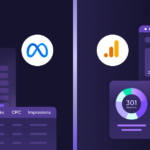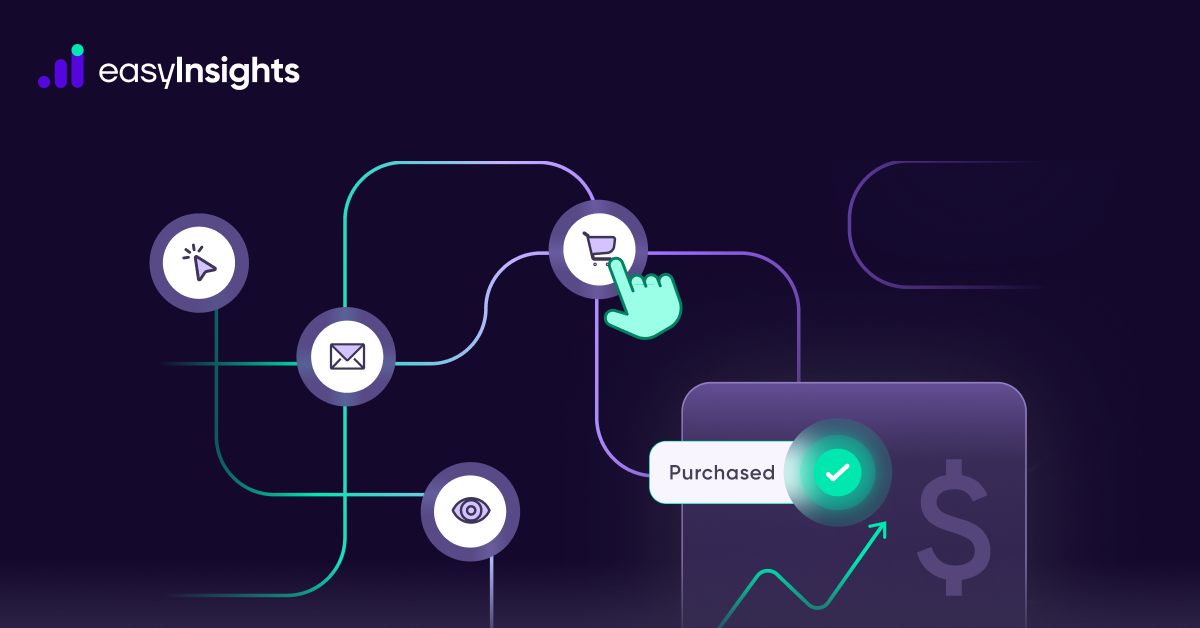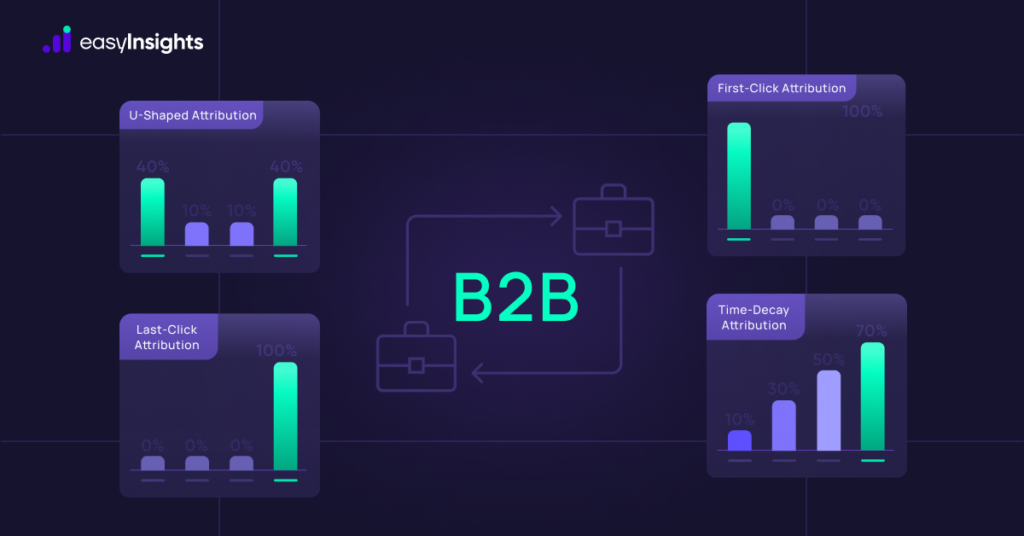
Dreamdata finds that an average B2B buyer has around 31 touchpoints with your brand before they decide to make a purchase. With an explosion of online channels and a never-ending stream of content, tracking what marketing touchpoints influence B2B prospects and nudge them toward a sale has become increasingly difficult and complex. Fortunately, B2B marketing attribution is here to save the day. This analysis technique allows you to navigate the turbulent waters of modern-day B2B marketing by helping you connect the dots across your varied and dispersed customer touchpoints.
It helps you optimize marketing budgets, calculate Return on Ad Spend (ROAS) accurately, and analyze the overall impact of your marketing campaigns effectively. If you’re wondering what this magic formula is, we’ve got you covered.
Here, you get the ultimate guide to marketing attribution for B2B businesses, exploring what it is, how it works, and its benefits. We also give you a roadmap to building your own B2B marketing attribution and tips to optimize it.
Jump ahead to:
First-Click Attribution Model vs Multi-Touch Marketing Attribution Model
B2B marketing attribution is an analysis method that helps you measure the impact of your marketing touchpoints on revenue and conversions across the customer journey.
It allows you to gain targeted data on how your campaigns are performing to help identify which are working and which need improvement. This, in turn, empowers you to allocate resources better and drive campaign performance.
The B2B marketing attribution technique involves assigning values to each customer touchpoint based on its influence on conversions. There are many types of attribution models. The two chief ones are the first-touch attribution model and the multi-touch attribution model. Here’s a look at these.
First-Click Attribution
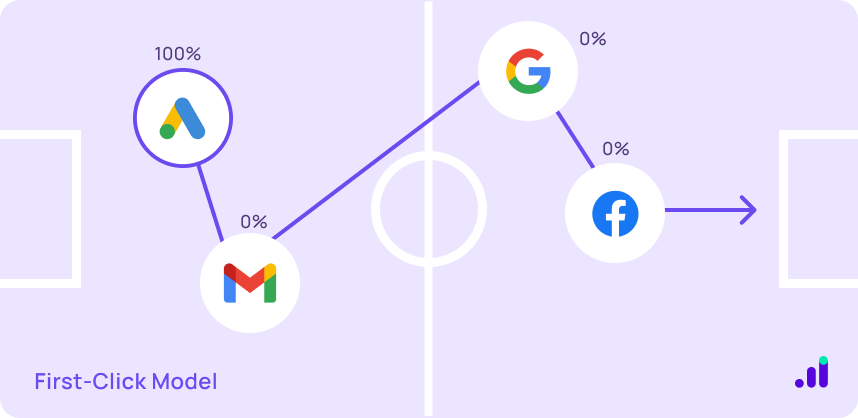
This model gives 100% credit for the eventual conversion to the user’s very first interaction. The idea here is to attribute all the revenue from the sale to the touchpoint that initiated the customer journey.
To use this model, you need to track and record the very first touchpoint that your prospect interacts with. This could be anything from a website visit to attending an online webinar.
This attribution model is ideal for businesses that engage in top-of-the-funnel marketing activities like content marketing and events to drive lead generation efforts. It empowers marketers to identify which touchpoints promote initial awareness and engagement within their target audience.
Multi-Touch Attribution
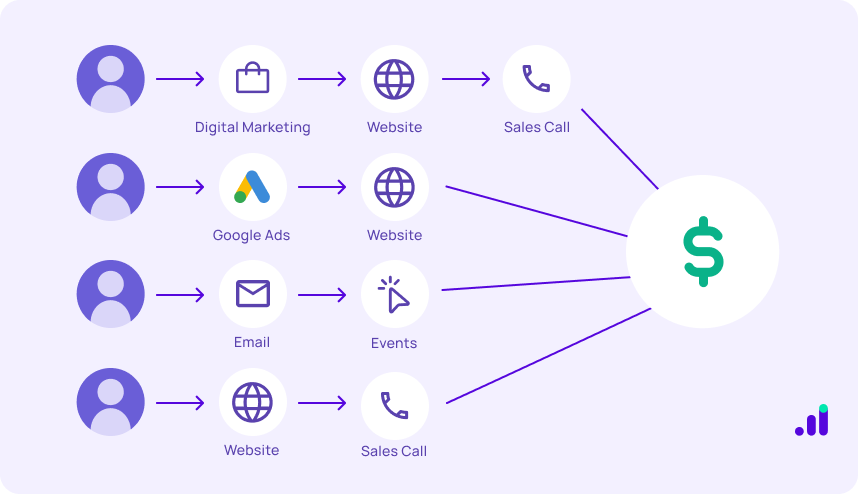
This model assigns credit to multiple touchpoints across the customer journey. Here are the types of multi-touch attribution models:
- Linear Attribution assigns credit for the conversion evenly across all customer touchpoints.
- U-Shaped or Position Based Attribution involves the first and the last touchpoints being credited with 40% of the conversion each while the remaining 20% is divided equally across the remaining touchpoints between the two.
- Time-Decay Attribution attributes credit to all touchpoints. However, the most recent ones are attributed a higher percentage than the others. The idea here is that the customer touchpoint closer to the conversion nudged the user towards the purchase more effectively than the older ones.
To leverage the multi-touch attribution model, marketers have to recognise and track the touchpoints that prospects engage with during their journey as well as understand the sequence of this engagement.
This model is ideal for businesses with lengthy, complex customer journeys with multiple touchpoints. It helps provide a comprehensive view of the customer journey by empowering marketers to understand the impact of every touchpoint on the eventual conversion.
Here’s a look at how these two models differ:
| Basis | First Touch Attribution Model | Multi-Touch Attribution Model |
| Credit Attribution | Credit is attributed to the first touchpoint only. | Credit is attributed to multiple touchpoints across the journey. |
| Best Suited for | Ideal for businesses with short sales cycles and simple customer journeys | Ideal for businesses with lengthy sales cycles and complex journeys. |
| Touchpoint Values | Attributes greater credit to top-of-the-funnel activities and none to bottom-of-the-funnel touchpoints. | Attributes credit to all touchpoints that have played a role in converting the lead. |
| Accuracy and Comprehensiveness | It is not as accurate or comprehensive as the multi-touch model, as it only attributes credit to the first touchpoint. | Offers an accurate and comprehensive understanding of the customer journey by attributing credit to multiple touchpoints across the customer journey. |
Additional read: Everything You Need to Know About Marketing Attribution Models
Benefits of B2B Marketing Attribution
Here are the advantages of marketing attribution:
- Offers Complete Customer Journey Insights
Marketing attribution helps you connect the dots between every customer touchpoint involved in the customer journey. As a result, you gain a deep understanding of where, when, and how your leads engage with your campaigns.
- Facilitates Improved Resource Allocation and ROI Optimization
By allowing you a complete overview of your campaigns and channels, marketing attribution allows you to identify what’s working and what’s not. This instant feedback helps you tweak your campaigns in time before they drain your resources while also allowing you to make more informed decisions during marketing budget discussions.
- Helps Drive Personalization
With marketing attribution, you get targeted answers to questions such as:
- What content is resonating with your ICP?
- What channels are best to connect with a specific audience segment?
- How can I optimize social and offline events to drive lead generation?
With marketing attribution, you’re able to assign credit to customer touchpoints that are actually driving the conversion rates. This helps you recognize what your customers’ preferences, goals and struggles are and create personalized content accordingly.
Challenges Associated with B2B Marketing Attribution
While marketing attribution offers significant benefits, it also has its share of challenges. Here’s a look at these:
- Limited Knowledge and Skill Set
Lead tracking is becoming increasingly tricky. Manually tracking leads from the beginning to the end of their journey can be challenging because of the growing touchpoints and other variables. Today, tracking leads requires extensive coordination, skill, and, most importantly, time that marketing and sales teams don’t have.
- Limited Access to Technological Resources
With the sheer number of touchpoints involved in the average customer journey, tracking leads and pinpointing touchpoints that were most instrumental in their conversion can be difficult, especially without the right tech stack.
Unfortunately, while many solutions are available in the market, companies today continue to rely on manual tracking, which is not only time-consuming but also prone to mistakes.
Consider integrating EasyInsights into your tech stack to streamline marketing attribution.
- Growing Cross-channel User Journeys
Lead tracking has always been difficult, but the rise in the number of digital communication channels has made it even more challenging for marketers. As we mentioned earlier, prospects today have as many as 31 touchpoints with the brand before they convert. Pair that with a lengthy sales cycle, and you might be able to determine the start and the finish of the customer journey but not so much the actual in-between journey.
Build Your B2B Marketing Attribution Model
Now that you know what B2B marketing attribution is and its significant benefits, you’re likely gearing up to integrate it into your marketing operations. Here’s a step-by-step guide on how you can execute B2B marketing attribution:
Step 1: Define a Single Source of Truth
A single source of truth refers to a centralized data repository that captures every last marketing touchpoint and interaction. This is crucial as it helps keep all business departments on the same page, prevents data silos, and eliminates data discrepancies that might arise from aggregating data from multiple sources.
In other words, a single source of truth ensures that you always have access to accurate, updated, and reliable data.
Step 2: Source the Event Data About Your Leads from your Platform
Next, you need to ensure that your marketing touchpoints are tracking user data efficiently and that this data is being sent to our centralized source of truth. By ‘Events,’ we mean website visits, email opens, clicks, form submissions, and other customer engagements with your marketing campaigns.
This is an important step as analyzing event data allows you to recognize customer touchpoints that are driving your conversion rate.
Pro Tip: maintain consistency in tracking methodologies across your channels to ensure the integrity and accuracy of the data collected.
Step 3: Match Each Lead with the Channel They Initiated Their Journey From
Where did your lead come from? Answering this question is critical for effective marketing attribution modeling. To be able to connect each lead with a marketing channel, consider implementing tracking mechanisms such as device fingerprinting, server-side tracking, consent-based tracking, etc.
Step 4: Connect Your Leads to Your CRM
A signature aspect of B2B marketing is that you’re likely dealing with multiple stakeholders for a single conversion. Keeping that in mind, once you’ve collected your data and attributed their origin, your next step must be to consolidate all lead data concerned with one company under a single account.
This account-centric approach allows you to clearly ascertain the holistic impact of all your customer touchpoints with multiple stakeholders and assign credit in a manner that truly caters to the B2B sales cycle.
Step 5: Define Your Attribution Model
Next, you must select the attribution model. It’s important to note that this is more a process than a one-time decision, as your attribution model must consistently evolve with your marketing needs. As discussed previously, there are many types of B2B marketing attribution models.
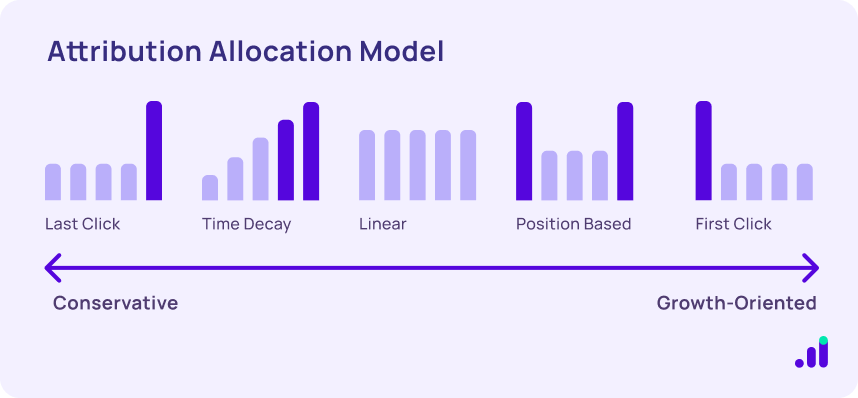
Choosing the right one depends directly on your marketing goal. For instance, if your aim is to drive sales, your attribution model should emphasize bottom-of-the-funnel activities. If the goal is to spread brand awareness, top-of-the-funnel activities should be the focus.
Step 6: Visualize Your Attribution Model and Extract Insights
Interactive dashboards, detailed charts, and similar features can help you visualize your attribution model and gain a comprehensive view of all your marketing efforts. Once your model is up and running, get started on extracting your insights.
As you might have noticed, building your own B2B marketing attribution model can be cumbersome, hectic, and—not to forget—extremely resource-draining. Instead, consider onboarding EasyInsights. The EasyInsights Pixel operates on server-side tracking principle and manages your marketing attribution seamlessly.
B2B Marketing Funnel: An Introduction
The B2B marketing funnel visualises the customer journey from start to finish, i.e. from the initial awareness to the final conversion. It consists of six stages: awareness, interest, consideration, intent, evaluation and finally buy.
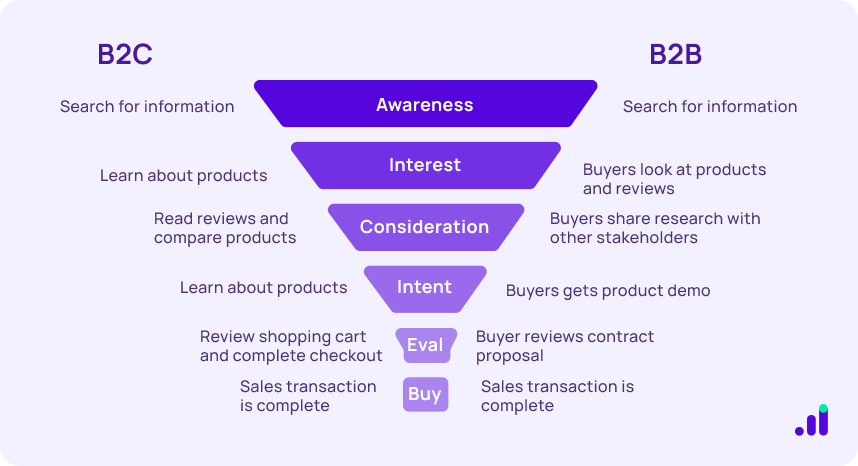
The decision maker will likely engage with multiple touchpoints through the funnel. For instance, they might:
- Read your blog while searching for a solution to your problem
- See your LinkedIn ad
- Engage with retargeting ads
- View your G2 ad while studying solution reviews
- Enter into your email marketing campaign
- Watch a webinar you sent through your email marketing efforts
- Schedule a demo with your sales team
These are just a few examples of how your B2B prospect can engage with your touchpoints across the funnel.
B2B Marketing Attribution: Best Practices
Here are some tips that can help you optimize your B2B marketing attribution:
- Integrate a multi-touch attribution model to gain a holistic understanding of the customer journey and which customer touchpoints are having the maximum impact on sales.
- Use marketing attribution tools that seamlessly integrate with your current tech stack to ensure data can be collected and analyzed easily.
- Experiment with new types of campaigns and touchpoints, such as conversational marketing, influencer marketing, and personalized content experiences, to examine how your marketing efforts can be improved.
- Leverage powerful tools such as EasInsights, which help you take a data-driven approach to attribution and offer cutting-edge capabilities such as machine learning to gain granular insight into your ad campaigns and customer touchpoints.
Supercharge your B2B Marketing with EasyInsights

EasyInsights is a leading marketing attribution tool that helps you pull back the curtain on the entire customer journey right from the nameless online user to a loyal customer through powerful first party data. It helps you supercharge your marketing efforts by:
- Integrating all your visitors’ interactions with your marketing campaigns seamlessly into your CRM.
- Helping you track how your campaigns are affecting sales through advanced multi-touch attribution to uncover its accurate ROI.
- Offering cutting-edge machine learning capabilities that leverage your own first party data to help you thrive in the post-cookie world.
- Allowing you to optimize your ad spend by helping you predict diminishing returns.
Long story short, EasyInsights gives you complete insight into exactly how each customer touchpoint is performing, empowering you to navigate your customer journey effectively to drive revenue.
To learn more about EasyInsights, book a demo today!
Additional read: Top 8 Marketing Attribution Tools and Software for 2024



